
Hiking Around Las Vegas, Grand Canyon National Park

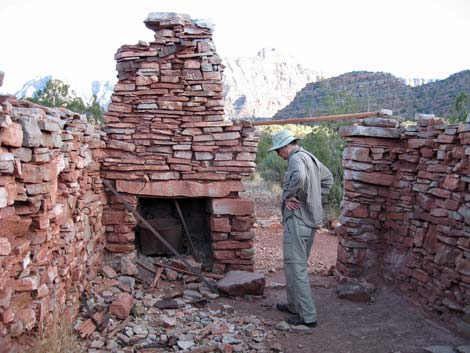 Remains of the stone building (view E) |
Overview The Cottonwood Trail is one of three routes that lead down off Horseshoe Mesa to the Tonto East Trail, this one running down the west side of Horseshoe Mesa and ending in Cottonwood Canyon. This trail is steep, narrow, and exposed, but it is easier and safer than the Page Spring Trail. Good water is available at Cottonwood Spring and sometimes farther down the canyon at the Tonto East Trail. Through the Redwall, the trail requires careful attention, but there is a real trail (well, mostly, a log in one place gives the illusion of security). Below the Redwall, the trail runs straight down the dirt hillside and is very steep with loose gravel and rocks, but the trail is fine and the grade moderates when the trail hits the bottom of the canyon. From there, the trail runs down the canyon, passes Cottonwood Spring, and ends at the Tonto East Trail atop the Supai Sandstone. Link to trail map. |
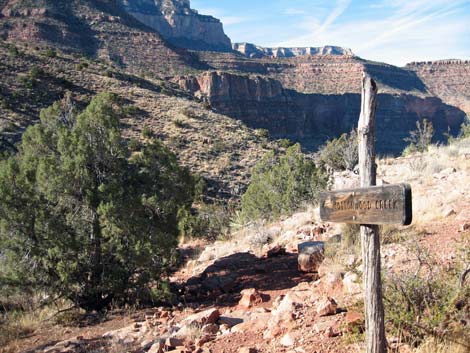 Grandview-Cottonwood trail junction (view W) |
Watch Out Other than the standard warnings about hiking in the desert, ...the trail through the Redwall is steep, narrow, and exposed. There are places where it is possible to slip in the gravel and fall into oblivion. Mines are inherently interesting, but it is never safe to enter holes in the ground. We drank raw water from Cottonwood Spring and Cottonwood Creek, but it would have been safer to treat it. While hiking, please respect the land and the other people out there, and try to Leave No Trace of your passage. Also, this is a long hike, so be sure to bring the 10 Essentials. |
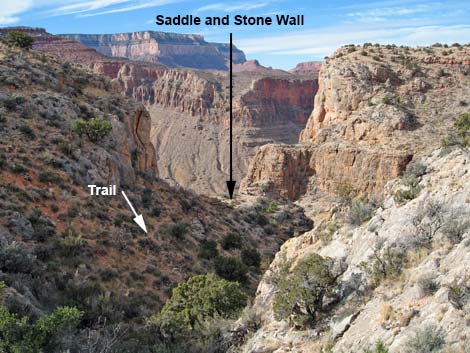 |
Getting to the Trailhead From Las Vegas, drive out to the South Rim of Grand Canyon National Park. From the South Rim Visitor Center (Table 1, Site 811), drive east on South Entrance Road (Hwy 180) to Highway 64 (Site 951), the road to Desert View. Turn left towards Desert View and drive east for about 12 miles to the Grandview Point turnoff (Site 952). Turn left onto the Grandview Point access road and drive north to the parking area at the end of the road (Site 953). Park here; this is the trailhead. |
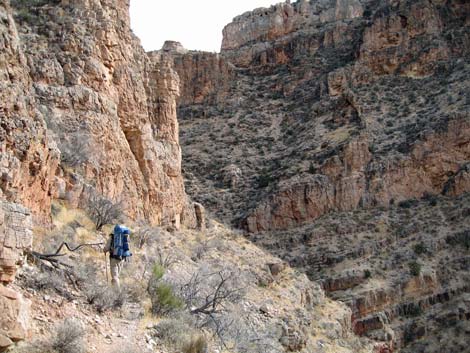 Looking back at hiker on ledge (view SE) |
The Hike From the trailhead on the South Rim (Table 2, Waypoint 1), the route follows the Grandview Trail for 3.0 miles to Horseshoe Mesa (Wpt. 12), which is the top of the Redwall Limestone and about half-way down to the Colorado River. The Grandview Trail ends on Horseshoe Mesa at the old stone building (Wpt. 12) that served as the cookhouse for the Last Chance Mine during the 1890s. For details of getting to the stone building, see the Grandview Trail. From the old stone building (Wpt. 12), backtrack about 20 yards to the Grandview-Cottonwood trail junction at the bottom of a shallow ravine (Wpt. 64). The Cottonwood Trail runs west down the ravine, passing the garbage pile below the stone building and a couple of old mines. Remember that the rusty cans are protected as historical objects, and that the mines (especially the first one) are dangerous. |
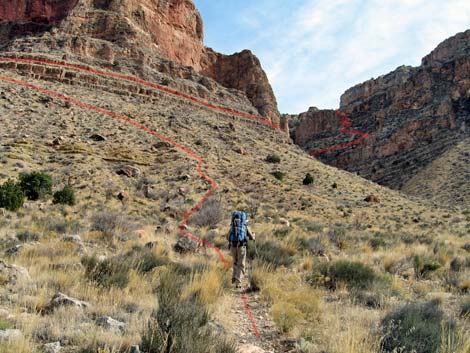 Looking back at hiker on hillside (view SE) |
The trail runs down the gully, then down and across a steep hillside as it starts towards the vertical cliffs on the edge of Horseshoe Mesa. The trail runs out onto a rocky saddle (Wpt. 63) with the remains of an old stone wall and a barbed-wire fence. Perhaps the miners had trouble with their mules escaping and running down the trail to the spring. Below the rocky saddle (Wpt. 63), the trail becomes narrow, steep, and rocky, but except for a couple of short spots, it is a fine trail. The trail switchbacks down the steep hillside to just above the ravine at the bottom, then runs down along the ravine until crossing to the north side of the canyon. The trail continues down along the north side of the ravine until turning out of the canyon and into Cottonwood Canyon, proper. |
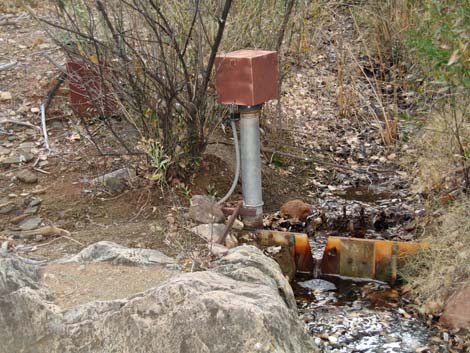 Cottonwood Spring stream-flow gauge (view W) |
The trail then runs north on a horizontal ledge at the base of the Redwall Limestone for a few hundred yards. When the ledge ends (Wpt. 61), the trail briefly angles back across the hillside beneath the ledge, then runs steeply down the hillside on tight, little switchbacks that zigzag most of the way to the bottom of the canyon. The trail hits Cottonwood Wash (Wpt 60) and crosses to the other side a few yards above a nice campsite under a big Utah Juniper Tree (Wpt. 59). From there, the gentle trail continues north along the west side of Cottonwood Canyon to an unmarked junction with a spur trail (Wpt. 55) that leads west along the south side of a ravine towards Cottonwood Spring. The spring is somewhere way up the side canyon, but a solar-powered stream gauge (Wpt. 54), about 100 yards up the canyon, is near where the spring is marked on the map. |
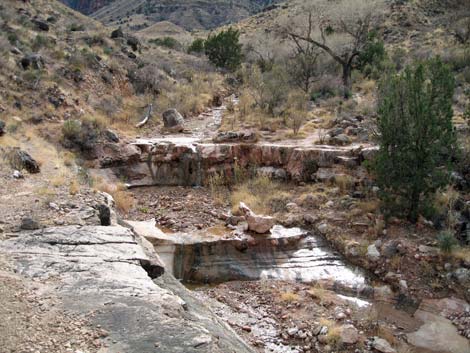 Tonto East-Cottonwood junction (view S) |
The Cottonwood Trail continues north from the junction for about 100 yards, then drops steeply into the ravine to Cottonwood Creek. Beneath Cottonwood Trees, this is a nice place to stop for water and rest, and there are 2 or 3 nice campsites in the immediate area. The Cottonwood Trail continues north along the west side of Cottonwood Creek. It seems that the trail used to run along the west edge of Cottonwood Creek, but parts of the stream bank washed out, and now the trail drops into and crosses the wash several times. There is some multiple-trailing, but the main trail is fairly easy to follow and mostly stays atop the bank on the west side of the creek. |
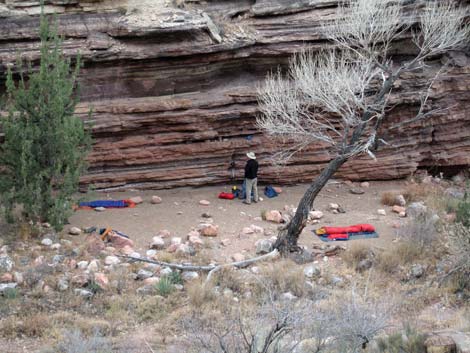 Camp on Cottonwood Creek (water is hidden from view below the bank in front of cottonwood tree (view W from Tonto East Trail). |
Native peoples used the canyon, and the trail runs across the top of a large agave-roasting pit (Wpt. 57) about 200 yards before getting to the Tonto East Trail. The Cottonwood Trail ends at a junction with the Tonto East Trail (Wpt. 56) atop the Supai Sandstone on the west side of Cottonwood Creek. When the creek is running this far down, it runs over a pretty slickrock pour-over just below the trail junction. There are several campsites in the area, but perhaps the best is about 125 yards farther down the creek (Wpt. 52) in the shade of the Cottonwood Trees. |
Table 1. Highway Coordinates (NAD27, UTM Zone 12S). NOTE: This is UTM Zone 12. Download Highway GPS Waypoints (*.gpx) file.
| Site | Location | Latitude (°N) | Longitude (°W) | UTM Easting | UTM Northing | Elevation (feet) | Verified |
|---|---|---|---|---|---|---|---|
| 811 | Visitor Center, Canyon View Information Plaza | 36.0590 | 112.1085 | 400166 | 3990857 | 7,092 | Yes |
| 951 | Highway 180 at Highway 64 | 36.0519 | 112.1049 | 400477 | 3990072 | 7,104 | Yes |
| 952 | Highway 64 at Grandview Access Road | 35.9895 | 111.9920 | 410581 | 3983037 | 7,489 | Yes |
| 953 | Grandview Point parking area | 35.9979 | 111.9870 | 411039 | 3983967 | 7,418 | Yes |
Table 2. Hiking Coordinates based on GPS data (NAD27; UTM Zone 12S). Download Hiking GPS Waypoints (*.gpx) file.
| Wpt | Location | Easting | Northing | Elevation (ft) |
|---|---|---|---|---|
| 01 | Grandview Trailhead | 411047 | 3984027 | 7,418 |
| 12 | Stone building | 412122 | 3986440 | 4,865 |
| 64 | Grandview Trail at Cottonwood Trail | 412143 | 3986420 | 4,872 |
| 63 | Rocky saddle above steep hillside | 411959 | 3986405 | 4,708 |
| 62 | Back of the canyon | 411888 | 3986469 | 4,437 |
| 61 | North end of ledge | 411653 | 3986636 | 4,393 |
| 60 | Bottom of Cottonwood Canyon | 411375 | 3986526 | 3,999 |
| 59 | Campsite under pinyon pine | 411355 | 3986529 | 4,038 |
| 55 | Cottonwood Creek Trail at trail to spring | 411105 | 3986853 | 3,896 |
| 54 | Solar powered stream gauge | 411026 | 3986802 | 3,891 |
| 58 | Crossing creek from Cottonwood Spring | 411100 | 3986922 | 3,863 |
| 57 | Agave-roasting pit | 411017 | 3987453 | 3,749 |
| 56 | Cottonwood Canyon at Tonto East Trail | 410989 | 3987636 | 3,683 |
| 52 | Camp below the Tonto East Trail | 410951 | 3987754 | 3,638 |
Happy Hiking! All distances, elevations, and other facts are approximate.
![]() ; Last updated 240326
; Last updated 240326
| Hiking the Grand Canyon | Hiking Around Las Vegas | Glossary | Copyright, Conditions, Disclaimer | Home |